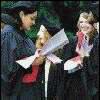 |
|
YORK UNIVERSITY PHYSICISTS PART OF INTERNATIONAL TEAM ON THE BRINK OF FUNDAMENTAL NEW DISCOVERY TORONTO, April 10, 1997: Two York University professors are involved in an international physics research project that has the science world abuzz with the possibility of a new discovery related to the way the world is put together. York University physics professors Sampa Bhadra and Bill Frisken are among more than 400 scientists from 12 countries on an experimental research team called ZEUS which has been working on a particle physics project based at the Deutsches Elektronen-Synchrotron (DESY) laboratory in Hamburg, Germany. Scientists have been using a particle accelerator there to examine the minutiae of matter that makes up everything in the universe. The ZEUS team recently realized that it may have discovered a leptoquark, a bizarre hybrid particle. Furthermore, a rival team of 400 physicists has corroborated the ZEUS team's observations. Physicists have speculated on, but never proven, the existence of leptoquarks. If further data supports the existence of leptoquarks, it will be considered the discovery of the decade in physics, providing another clue about the underlying fundamental structure of the world and all of the matter in it. Particle physics is the science of the fundamental nature of matter. For 30 years, particle physicists have been sorting the smallest, apparently indivisible subatomic particles into two distinct families -- quarks and leptons -- from which all other particles are made and which together make up the atoms that form everything in the material world. The leptoquark, if it exists, would be part lepton and part quark and would bridge the two families that have always seemed completely unconnected. "York University is a founding member of the ZEUS project and has made several important contributions to it," said York physics professor emeritus Bill Frisken. "We can be very proud of our presence on this international team which is now beginning to blaze new trails in physics after many years of painstaking research." Although both teams suspect they may have observed the tracks of a leptoquark, they caution that it will take another year of observations to make a conclusive statement. If it turns out to be a leptoquark, it will revolutionize the world of physics and oblige physicists to rewrite the Standard Model, the theoretical framework that underlies all physics. The ZEUS team's observations between 1994 and 1996 resulted in five sightings of anomalies that they spotted using powerful computers which reviewed information from the experiment that had been written to magnetic tape. These unusual sightings excited physicists, who believe this may be a key stepping stone in their elusive search for a "theory of everything" explaining all physical phenomenon. "If this turns out to be leptoquarks or any of the other exciting possibilities, it will shake up the world of physics," said York physics professor Sampa Bhadra. "The Standard Model describes all of physics, so if you can prove conclusively that you have found something that does not fit, it will be exciting beyond belief. This kind of discovery does not happen very often." There are other possibilities besides the existence of leptoquarks that would explain these anomalies. Most of these possibilities would be just as exciting, and lead to the overturning of the Standard Model. The model describes the world from the ground up, from the architecture of atoms to the reactions that power the sun. Any of the possibilities would point scientists in the direction of finding the "theory of everything." One disappointing possibility would be that the observations are due simply to a statistical fluctuation. For instance, if you flip seven coins, it is possible that all seven will land heads up. However, as you flip more coins, it becomes less likely that all of them will land heads up. Another year of observations will reduce the likelihood of statistical fluctuation. Bhadra was responsible for running a complex set of very fast computer programs on a system of parallel processors used to pre-select and record interesting particle collisions, such as the leptoquark candidates. She was active in the design of the hardware, as well as in the coding and implementation of the software. Frisken, who helped build the hybrid particle collider, collaborated on the design and prototyping for large modules that formed the calorimeter. The calorimeter is used in the ZEUS detector to measure the energy of particles and is vital to understanding what happens in particle collision. Bhadra and Frisken are listed among the 420 authors on the ZEUS team's collaborative paper, which has been submitted for publication in the physics journal Zeitschrift fur Physik. Other York contributors listed include PhD student Mohsen Khakzad and postdoctoral research associate Bill Schmidke, who are now working at the DESY facility in Hamburg, Germany.
For more information, view the ZEUS project's Web site at:
Professor Sampa Bhadra
Professor Bill Frisken
Mary Ann Horgan |
|
|
| | Welcome to York University | Latest Release | Release Archives | |
![[to York's Home Page]](../../images/yorklogos.gif)
